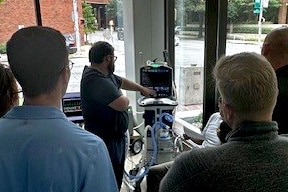Clinical Simulation, Pulmonary Division pilot new ASL 5000 sim

A collaboration between UAB Clinical Simulation and the Division of Pulmonary, Allergy and Critical Care Medicine is breathing new life into pulmonary learning curriculum.
Clinical Simulation recently supported a new pilot experience featuring the ASL 5000 lung simulator, a device that models realistic respiratory mechanics and enables advanced ventilator management training.
The course, typically offered and facilitated by faculty at the National Institutes of Health (NIH) in Maryland, was brought to UAB through collaboration with Dr. Jonathan Kalehoff and colleagues Drs. Daniel Scullin, Abdulhakim Tlimat and Steven Fox, all from the UAB Division of Pulmonary, Allergy and Critical Care Medicine.
Kalehoff had been invited to attend a four-day, NIH-facilitated mechanical ventilator course, and, while there, something clicked.
“We thought we’d like to join this program and launch a deeper curriculum,” he said. “However, part of that required a lung simulator.”
But not just any simulator. This program would require a high-fidelity model to furnish the most effective, comprehensive learning experience. Recalling previous collaborations with Clinical Simulation, Kalehoff reached out and learned that the center had two ASL 5000 units available for simulation experiences.
“The simulation team was more than willing to work with us,” Kalehoff said.
To prepare for the pilot, Clinical Simulation and the faculty team partnered to develop, test and refine course resources, including the supported use of ASL 5000 devices outside the simulation center. According to Andres Viles, Clinical Simulation’s director of immersive simulation, the goal was to help UAB faculty become independent facilitators, allowing the course to be offered on site in the future.
“Oftentimes, collaborations like this can involve a lot of red tape, but (Clinical Simulation) kept the focus on education,” Kalehoff said. “Andres was incredibly flexible and willing to work with us. A lot of us in our group had to learn how to program the ASL 5000, so we ended up visiting the sim center at various times to learn what we needed to facilitate the course.”
The pilot session, held in August, marked the first time the ASL 5000 equipment and materials were used in a learner environment outside the sim lab.
“I think it was a great experience,” Kalehoff said.
The out-of-lab simulation featured 28 learners and was held in O’Neal Comprehensive Cancer Center to accommodate the larger group size. Kalehoff and colleagues are already seeing its effect.
“We’ve already seen improved patient care,” Kalehoff said. “Some of the fellows and respiratory therapists who went through the course are already reaching out, sending pictures, saying they made adjustments while treating real-life patients. So, we see it’s actually applying to and affecting real-world situations.”
Based on its success, the simulation is expected to become an annual offering and may eventually be hosted within UAB Clinical Simulation’s dedicated training spaces to utilize high-fidelity manikins in immersive scenarios, Kalehoff said.
“This will be turned into an annual experience that we’ll offer not only to UAB, but to people across the Southeast,” he added. “The goal is to be a hub for this curriculum.”
To learn how simulation can benefit your own team or department, email simulation@uabmc.edu.
UAB Medicine’s Clinical Simulation program offers opportunities for individuals and teams across UAB Medicine and beyond to practice before they deliver care. We encourage all who provide and support patient care to “Sim First.” Together, we can put our patients’ safety first.




0 Comments